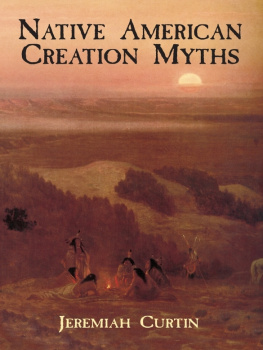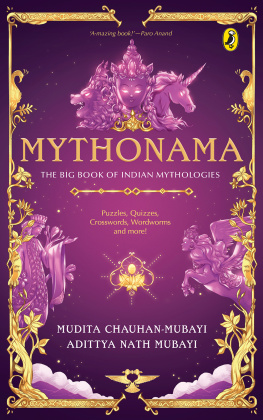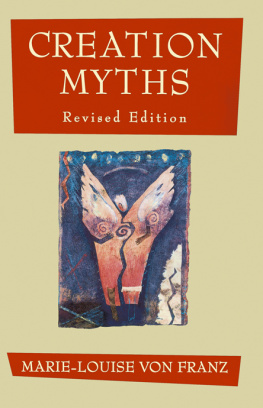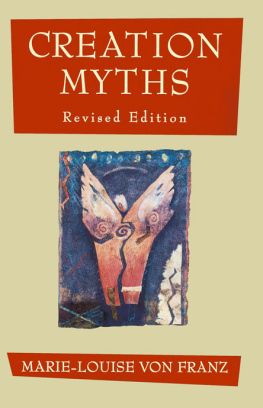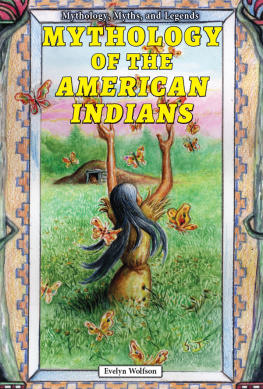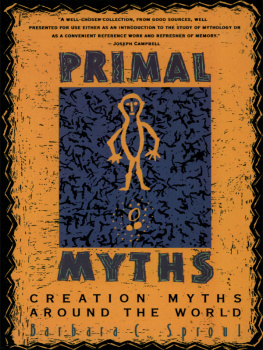OTHER BOOKS BY TERESA PIJOAN
Ways of Indian Magic
Sunstone Press, Santa Fe, NM
Pueblo Indian Wisdom
Sunstone Press, Santa Fe, NM
Dead Kachina Man
Sunstone Press, Santa Fe, NM
White Wolf Woman
August House Press, Little Rock, AR
Spanish-American Folktales
August House Press, Little Rock, AR
La Cuentista, Bilingual Stories
Red Crane Books, Santa Fe, NM
Listen a Story Comes
Red Crane Books, Santa Fe, NM
Stories from a Dark and Evil World
Red Crane Books, Santa Fe, NM
Lexicon of the Southwest
Zui Press, Albuquerque, NM
AMERICAN INDIAN
CREATION MYTHS
Teresa Pijoan, Ph.D.
SANTA FE
Chapter illustrations by Claire M. Connally
Book design based on design by Judy Burkhalter
Cover artwork by Nicole D. Pijoan-Garling and Claire M. Connally
2005 by Teresa Pijoan. All rights reserved.
No part of this book may be reproduced in any form or by any electronic or mechanical means including information storage and retrieval systems without permission in writing from the publisher, except by a reviewer who may quote brief passages in a review.
Sunstone books may be purchased for educational, business, or sales promotional use. For information please write: Special Markets Department, Sunstone Press, P.O. Box 2321, Santa Fe, New Mexico 87504-2321.
Library of Congress Cataloging-in-Publication Data:
Pijoan, Teresa, 1951-
Creation myths of the American Indian / by Teresa Pijoan.
p. cm.
ISBN 0-86534-471-X (softcover : alk. paper)
1. Indian mythologyNorth America. 2. CreationMythology.
3. Earth-Mythology. 4. Water-Mythology. I. Title.
E98.R3P53 2005
299.7'124dc22
2005021258
WWW.SUNSTONEPRESS.COM
SUNSTONE PRESS / POST OFFICE BOX 2321 / SANTA FE, NM 87504-2321 /USA (5O5) 988-4418 / ORDERS ONLY (800) 243-5644 / FAX (505) 988-1025
FOREWORD
A ll cultures, including our own, have creation myths. They vary from simple to very complex and from almost believable to quite absurd. They all attempt to answer the question of human origin.
Starting around ten thousand years ago, groups of people from Siberia and later China migrated across the Bering land bridge into the Americas. Over time they populated the continent from Alaska to Tierra del Fuego and their few original cultures grew into thousands of distinct groups.
The native peoples of North America are, even today, as varied in culture, language and physical looks as those of Europe. In the past there were even more distinctions. Some of these differences have been melded under the outside influences of the European settlers.
There was the introduction of European diseases, sometimes accidental, sometimes deliberate, into populations which had no immunity to them at all. There were too many battles to count. There was forced resettlement by the federal government which placed tribes from different geographic locations and different cultures into close proximity. In the 19th century, there were Indian Schools whose aim was to deculturize Native children by putting them into residential schools to live with those from other tribes and all were expected to speak English, become Christian and forgo their heathen ways. In the last half of the 20th century, television became omnipresent and there is now no reservation too remote to be reached by English language broadcasts of Sesame Street and CNN.
Despite all this, a few tribes have managed to hold onto their language and their religion. Many more still retain some of their culture including portions of their mythology.
We have no way of telling how much the mythology has changed during four centuries. We can be sure that the 21st century version of these stories is not exactly the same as was told to children in the 16th century but it may be very close.
The Native American creation myths could be classified by linguistic families or geography but in gathering this material it became apparent that there were only four basic stories being told over and over with localized variations. While these groupings are artificial they serve to organize a huge amount of material into useful segments.
There are the Sky Born, Earth Born, Water Born and Underworld Born peoples. Some have a creator, some don't and a few seem to have grafted a creator onto an older story that had none, perhaps under the influence of Christianity. Some received help from various animals or spirits in their creation.
The Sky Born people were cast down, jumped, fell, or pushed from a Sky Vault or Great Tree of Life and landed on land, water, the back of a turtle or a floating island.
The Earth Born people were created, developed or spontaneously arose from the earth or mud. The story in Genesis clearly places Adam and Eve into the Earth Born group.
The Water Born were also created, developed or spontaneously appeared from the mud or waters of the oceans, lakes or rivers of the world.
The Underground Born people were in one or more worlds under this one and climbed out through a Navel of the World. They were sometimes guided by spirits or led out by animals.
There does not appear to be much correlation between the type of creation myth told and the geographic or linguistic group to which the tribe belongs. The Navajo and Apache tribes are both Athabascan, the last group to migrate to America, and moved into the Southwestern United States at about the same time yet the Navajos are Underground people and the Apaches Earth born.
Myths tell us much about a people. These creation myths tell us about the rich and varied lives and imagination of the first Americans.
Barbara Blair
PREFACE
T here are parts of life that are lost in busy every day needs. We the people believe that we are significant, made from the Creator, made to carry on, to hold life precious, to be the ones who do not forget. Yet, much is lost with television, magazines, movies, material needs, and domination. There are those who forgot and they suffered for it. Will this happen to us?
Creation is the basis for religion. Societies draw inferences about their origins from their civilization, coming from observations made from their spiritual concepts. Theologians classify religions different from the Judeo-Christian as myths in today's society. This term reflects a distorting stereotype of these societies which is not positive. In primal religions man is held in harmony with nature and people live in a sacred universe where there is not a separation between the physical and the spiritual world. There are universal similarities between native religions and traditions which emphasize common categories and religious expressions.
Religion is a total way of life, a practice held in every action, every thought, every vision. This is a vision of reality that provides harmony in the world, the community, the family, within the individual. The creation describes the balance of the cosmos since the beginning of time. Creation stories portray the cosmos related to the sacred, revealing the mystery, the balance, the purpose, the wisdom of being human. Most creation beliefs are not monogamous, but have a balance of spiritual beings who watch, protect, guide, punish, and bring forth life again and again.






